 |
| The Independent Traveler's Newsletter PAGE FOUR |
 |
| The Independent Traveler's Newsletter PAGE FOUR |
|
CHÂTEAUX
~ TREASURES OF THE LOIRE
. . . continued
This map will help you pinpoint the
châteaux and rivers mentioned in this feature.
Eastern Loire There are so many interesting and beautiful châteaux in the Loire to visit, but we can only touch on a few more in this issue. As we move eastward through the river valley, one cannot and must not overlook the Château de Chenonceau straddling the River Cher ~ one of the best known and one we have enjoyed visiting on several occasions. The château was built in three stages: the Marques Tower survived from the original castle built on the site in 1432 for Jean Marques II; the main château built in the waters of the Cher for Thomas Bohier in the 1510s; and finally, the bridge across the river begun by Philibert de l'Orme for Diane de Poitiers and later completed by Jean Bullant for Catherine de Medici. 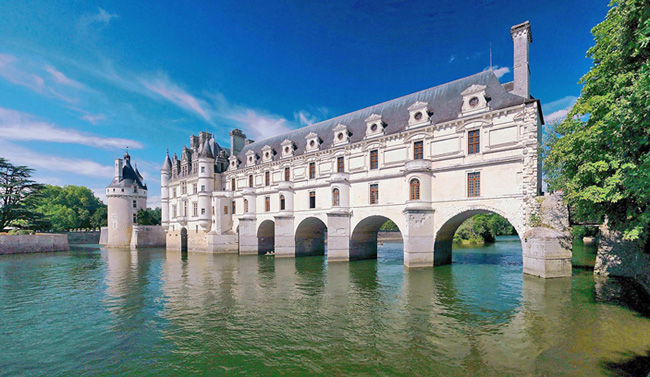 Château de Chenonceau (near the village of Chenonceaux) is often referred to as 'feminine', most likely for its graceful appearance as well as the fact that it was the home of both the King's mistress, Diane de Poitier, and following his death, occupied by his wife, Catherine de Medici. The château's Italian influence dates back to Thomas Bohier who traveled to Italy with three kings of France, including François I. Bohier had purchased the château from Pierre Marques in 1513 and demolished all but the Marques Tower and constructed the living quarters of the château with much input from his wife Catherine, from a wealthy financial family in the Touraine. The scandal and fall of the Receiver General of Finances brought the Bohier family down with him, even though Thomas had died in 1524 three years before the trial. The château was seized from Thomas' son by François I in 1535 to pay debts owed to the State. Following François' death in 1547, the château passed to Henri II who gave it to Diane de Poitiers, his mistress. It was she who had the arched bridge built across the Cher to reach the park on the far bank. Diane had vast gardens planted and was able to gain possession of the castle from the crown in 1555. Sadly, at the young age of 40, Henri died in a jousting tournament in Paris' Place des Vosges after being mortally wounded by the Count of Montgomery. His death changed everything for Diane de Poitiers. Catherine took control of Chenonceau, forced Diane to exchange it for the Château de Chaumont where Diane lived for only a short time. Catherine added the two-story galleries on the bridge, which today are certainly the main attraction for visitors. She also had her own gardens planted, but Diane's gardens are still there as well. 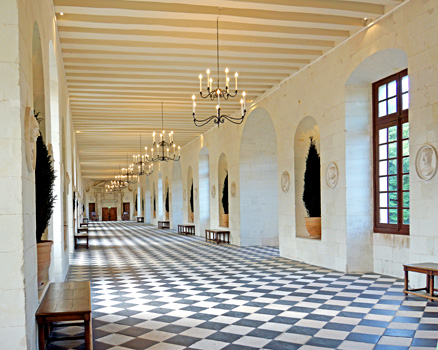 The gallery and aerial view of
Château de Chenonceau.
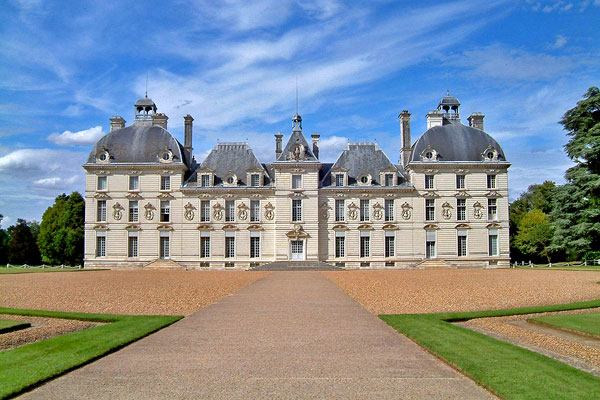 The Château de
Cheverny
is quite different from Chenonceau and the other châteaux we have
featured. First, it was built later in the 1620s and 1630s, and has
been in the same family ever since. In fact, the family lives in
the château, but many rooms are open to the public ~ 365 days a
year. A full guided tour of the château is offered and a
little train will also take visitors through the beautiful park. The Château de
Cheverny
is quite different from Chenonceau and the other châteaux we have
featured. First, it was built later in the 1620s and 1630s, and has
been in the same family ever since. In fact, the family lives in
the château, but many rooms are open to the public ~ 365 days a
year. A full guided tour of the château is offered and a
little train will also take visitors through the beautiful park. The owners boast that it is the most decorated and furnished château in the Loire, and that may well be true. Rooms are decorated in period style and are quite impressive with exquisite furnishings, tapestries and objets d'art. It is also a great place to bring children as activities are planned for those between the ages of 7 and 14. Belgian comic book creator, Hergé, based his fictional "Château de Moulinsart" (Marlinspike Hall in English) in The Adventures of Tintin books on this château. Henri Hurault, the Comte de Cheverny, military treasurer for King Louis XIII, purchased the lands for Cheverny, yet it is unknown if any of the original structure remains. His heir, Marquis Charles-Antoine de Vibraye, is the current owner. Lost to the state to settle debt, King Henri II gave it to Diane de Poitiers, but she preferred Chenonceau, so she sold the lands back to the Hurault family. Philippe Hurault, the former owner's son, then hired architect Jacques Bougier, whose design includes features found at the Palais du Luxembourg, and it was built between 1624 and 1630. The former owner's daughter, Marguerite, designed the interiors. In 1768 a major interior renovation was undertaken. Because they had to forfeit the family wealth during the French Revolution, the Hurault family sold the château in 1802. However, they bought it back in 1824 during the Restoration under King Charles X when the aristocracy was once more in a good financial and political position. The owner of the château opened it to the public in 1914 ~ one of the first owners in France to do so. It is a popular attraction and definitely one of the easiest châteaus to visit as all public rooms are on the ground floor. There is a café in the Orangerie, an 18-hole golf course on the estate and two picnic areas among many other attractions for visitors. 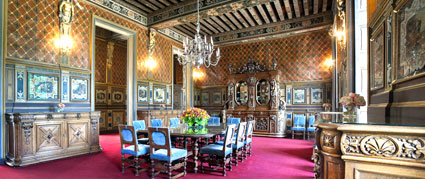 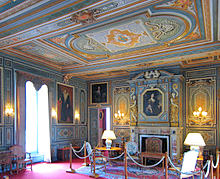 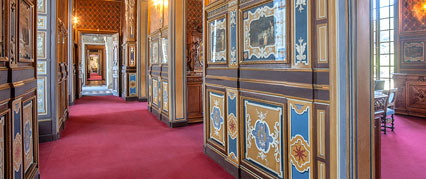 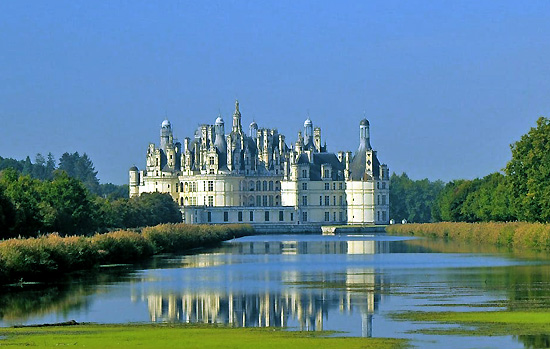 Although there are many other amazing châteaus in the Eastern Loire such as Blois, Sully-sur-Loire in the beautiful Sologne, and Amboise and Loches back in the Touraine ~ they will have to wait for another time. We will complete this feature with one that we don't think you should miss: Château de Chambord. Construction began in 1519, and as much as Chenonceau is feminine, Chambord has a definite air of strength and masculinity. Its web site tells us that it was built as imagined by François I and imbued with the spirit of Leonardo da Vinci whom he encouraged to move to France and the Loire Valley. We are also reminded that in the few hours you will visit you will explore a half millennium of French history. 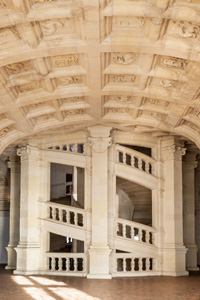 Located in the exceptional Sologne with the River Cosson winding its way through the property, it rose up from the marshlands with a central axis and the unique double helix stairway inspired by da Vinci. The château has an abundance of chimneys and towers, and was not actually completed until the reign of King Louis XIV. It was then that the parkland took shape with stables being built and the Cosson was canalized to sanitize the site. It was never used as a residence by François I but as a base for hunting, which Louis XIV did as well with his court in attendance. The 18th century saw the interior decorated and furnished as Louis let his father-in-law, the exiled King of Poland, live there. Subsequent occupants permanently furnished the château and its apartments, adorned it with woodwork, parquet and ornate ceilings. The structure of the château was spared during the Revolution, but the château interior was pillaged with its contents sold. After years of neglect, Napoleon I gave it to an aid whose wife sold it. By 1821 the estate was offered to the Duke of Bordeaux, grandson of King Charles X. The Duke, forfeited his right to the château when he denounced the French flag and his right to inherit the throne. He did maintain Chambord from a distance, made major restorations and opened it to the public. Since 1930 it has been the property of France when it was decided that, due to the Austrian nationality of the Bourbon-Parma family, they could not keep the château. 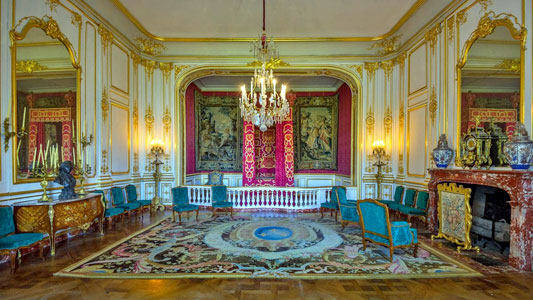 In more recent times changes have been made to make the château closely resemble is Renaissance past, so the Louis XIV attics were demolished. Back in 1840 it was listed as a French historical monument, as were its park and later the wall. In 1981 it became a UNESCO World Heritage site. Only photographs can accurately depict the grandeur of the exterior and the spacious interior of Château de Chambord, so we present several here ~ the double helix stair, the royal bed chamber, a hall in authentic period design, and two exterior views of the ornate and intricate structure of Chambord. 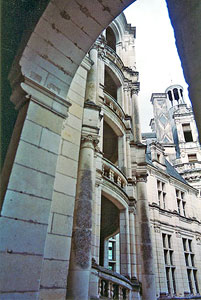 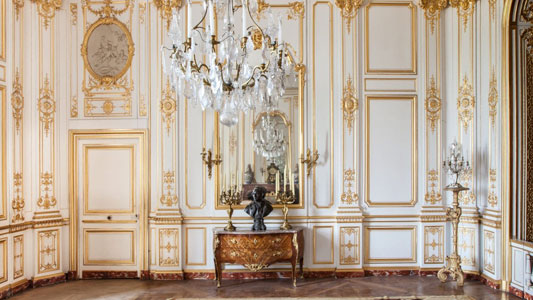 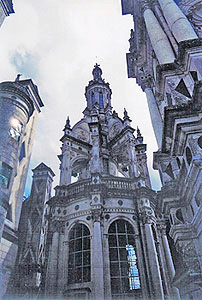 WHERE TO STAY IN THE LOIRE: Why not find accommodations suitable to the fine châteaux you will visit. At a wide range of prices, each offers luxury, history and accessibility to the châteaux we have featured in this issue. Some are bed & breakfasts and others are rented by the week or occasionally for short breaks. Please click on the links to visit each to learn all about them,. Western Loire Villa Belle Couronne, Château de la Caillotière, Château de Challain, Château Allure du Lac Central Loire Château de Détilly, Château de Reignac, Château de Bournand Eastern Loire Château du Breuil, Château de Rère 'Little Pompeii' Discovery by the Rhône
Sainte-Colombe,
France
A "little Pompeii" is how French archaeologists are describing an entire ancient Roman neighborhood uncovered on the outskirts of the southeastern city of Vienne, featuring remarkably preserved remains of luxury homes and public buildings. Benjamin Clement, the archeologist leading the dig on the banks of the River Rhône about 30 kilometers south of Lyon, said that they were unbelievably lucky. "This is undoubtedly the most exceptional excavation of a Roman site in 40 or 50 years." 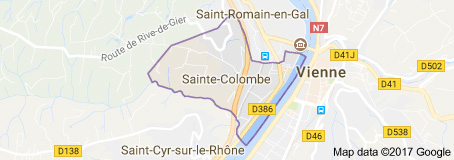 The city of Vienne, famous for its
Roman theatre and temple, was an
important hub on the route connecting northern Gaul with the Roman
province of
Gallia Narbonensis in southern France. The site unearthed on land
awaiting construction of a housing complex covers
an area of nearly 7,000 square meters (75,000 square feet) -- an
unusually
large discovery in an urban area that has been labeled an "exceptional
find" by the French culture ministry.
The neighborhood, which contains
homes dating to the 1st century AD, is
believed to have been inhabited for around 300 years before being
abandoned
after a series of devastating fires. Many of the
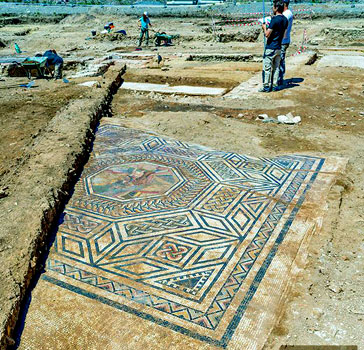 objects in
place when the inhabitants fled were conserved,
transforming the area into a "real little Pompeii in Vienne",
according to Clement, referring to the Roman city-state that was
largely
preserved after being buried by volcanic ash. objects in
place when the inhabitants fled were conserved,
transforming the area into a "real little Pompeii in Vienne",
according to Clement, referring to the Roman city-state that was
largely
preserved after being buried by volcanic ash.Among the structures to have partly
survived are an imposing home dubbed the
Bacchanalian House after a tiled floor depicting a procession of
maenads
(female followers of the god of wine, known variably as Dionysus or
Bacchus)
and joyful half-man, half-goat creatures known as satyrs. A
blaze consumed the first floor, roof and balcony of the sumptuous home,
which boasted balustrades, marble tiling, expansive gardens and a water
supply
system, but parts of the collapsed structure survived.
The
archaeologists believe the house belonged to a wealthy merchant.
Clement believes they will be able to restore the house from floor to
ceiling. Another building shows an exquisite mosaic depicting
Thalia, the muse and patron of comedy, being kidnapped by a lustful
Pan, god of the satyrs. These mosaics are being carefully removed
and taken away to be exhibited in Vienne's museum of Gallo-Roman
civilization in 2019.
Other finds include a large public building with a fountain adorned by a statue of Hercules, built at the site of a former market. Clement believes it may have housed a philosophy school. 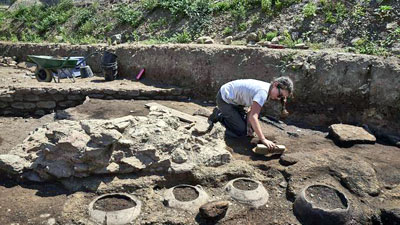 The
excavations began in April, and it was hoped they would be
completed in mid-September, but the French state has extended the
project until the end of the year to allow time for more finds.
In the coming months Clement and his team of 20 will dig down to older
parts of the site and explore an area thought to contain workshops. The
excavations began in April, and it was hoped they would be
completed in mid-September, but the French state has extended the
project until the end of the year to allow time for more finds.
In the coming months Clement and his team of 20 will dig down to older
parts of the site and explore an area thought to contain workshops. Clement
says that neighborhood was struck
by fire twice, once in the beginning of the second century and then in
the middle of the third. The fires, it turns out, are what preserved
the structures, carbonizing wooden beams and baking the bricks between
them. The fire also oxidized iron objects like hinges, ax heads and
doors, which normally rust away over time.
The Vienne area has long been an archaeological hotspot and likely founded when the Romans conquered the Gallic Allobroges tribe in 120 B.C. and resettled them on the site. After a tumultuous half century of revolts and pacification, the emperor Augustus granted Vienne the status of colonia and its inhabitants citizenship. It became a regional and cultural capital and its Roman theater, temple to Augustus and Livia, and an obelisk from its arena are still tourist attractions today. We would like to acknowledge Agence France
Presse and www.smithsonianmag.com
for providing the information to produce this article and the two photos. drive north of Sainte-Colombe. This lovely accommodation has since closed, but we haven't forgotten the story they told us about their sons claiming to have discovered an ancient tunnel under the Rhône from their eastern side to the western banks. Our hosts could not confirm this discovery and, in the time since, we have been unable to find any information about it. However, with the discovery not far away of "Little Pompeii", who knows if that tunnel will one day be officially uncovered?
DISCLAIMER: You have received this newsletter because your email address is on our Opt-In mailing list, i.e., you have requested to receive FRANCE On Your Own ©. If you would like to discontinue receipt of this newsletter, please send an email to publisher@franceonyourown.com with "unsubscribe" on the Subject line. Unless indicated otherwise, photos, graphics, artwork and text in the FRANCE On Your Own © newsletter are all the property of Cold Spring Press and FRANCE On Your Own © and cannot be copied, duplicated or used in any manner by anyone without the express written permission of Cold Spring Press. FRANCE On Your Own © is published online by Cold Spring Press, P O Box 26098, San Diego, California 92196-0098. This publication is copyrighted and no portions of the text, artwork, graphics or photographs may be reproduced or distributed in any form or by any means or stored in a database or retrieval system without the written permission of the Publisher. For more information about FRANCE On Your Own ©, visit our web site at http://www.franceonyourown.com. Recommendations made in this newsletter are based upon the personal experiences of the Publishers or contributing writers solely to provide information to subscribers. Cold Spring Press and FRANCE On Your Own © make no endorsements nor are any guarantees or promises of satisfaction given or implied. Any and all information is correct to the best of our knowledge, and the Publishers accept no responsibility for errors and/or omissions. The responsibility lies entirely with the traveler to obtain current information regarding accommodations, availability, schedules, prices, reservations, or any other pertinent details. We do not guarantee the historical accuracy of the contents of articles in this newsletter. Historical accuracy is dependent upon one's sources of information -- and contradictions often exist among those sources. Links to other web sites or email addresses are provided for informational purposes only and do not imply any guarantees of service or endorsement of any organization or their business practices. FRANCE On Your Own © is electronically transmitted via email. To add your email address to our database for this FREE newsletter, send an email to info@franceonyourown.com, and please put Subscribe in the subject line. We do not share email addresses with any other organization. BACK ISSUES of the print version of FRANCE On Your Own © and Free online back issues are available on our web site at http://www.franceonyourown.com/Archives.htm. ©1997-2017
Cold Spring Press All Rights Reserved
|
|
 previous
page
previous
page |